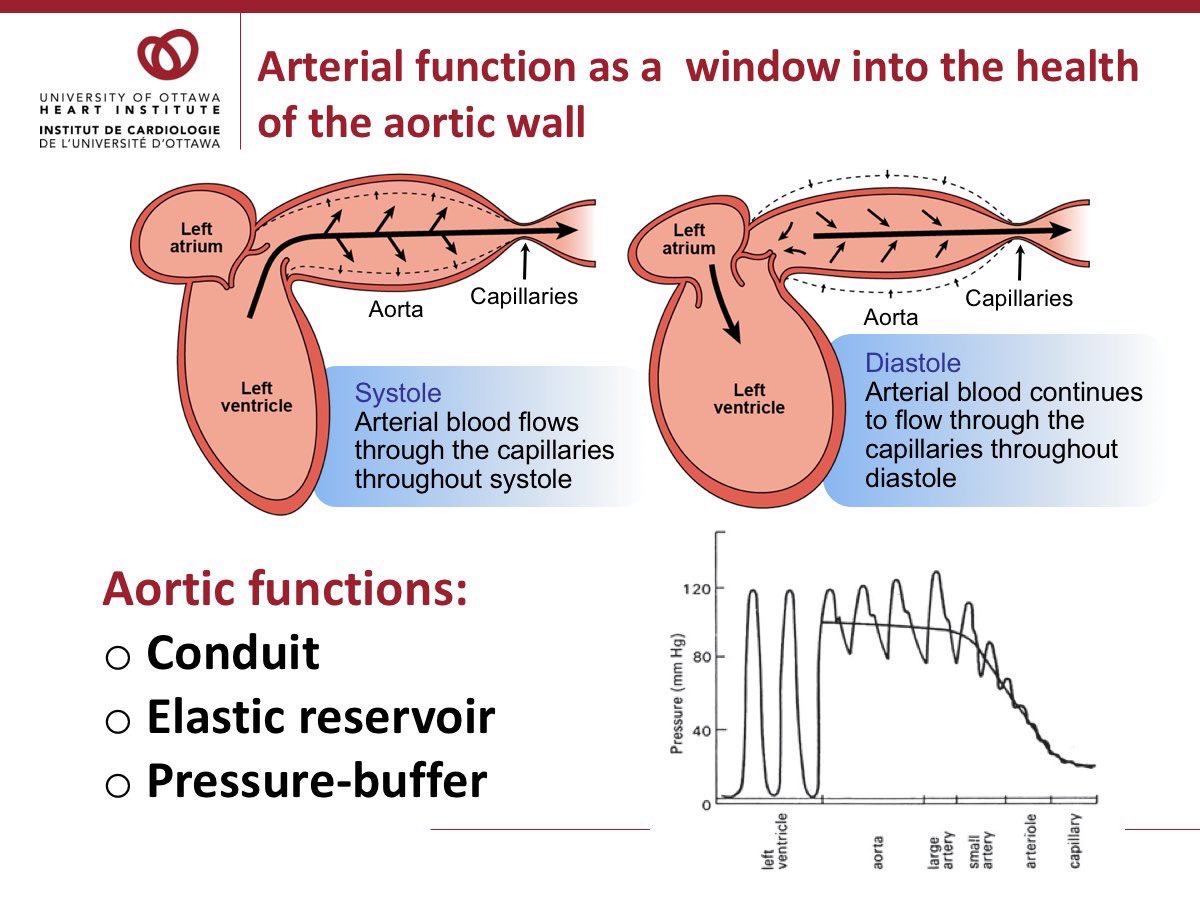1/19 Alright #CardioTwitter, here’s my first series of 2 #Tweetorials, and I’m going to call it: “The Aorta is Not Just a Pipe.” This is Tweetorial #1 focusing on normal aortic function. Tweetorial #2 will focus on abnormal aortic function.
2/19 The aorta is often viewed as a passive conduit of blood, when in fact, it has essential functions that aim to maximize cardiovascular efficiency and protect the end-organs. The conduit function is only 1 of the aorta’s functions.
3/19 All arteries pulsate, and for a particular function: which each beat, the heart generates a pulsatile energy – this energy is stored in the arterial wall during systole and released during diastole, allowing blood to keep moving forward throughout the cardiac cycle.
4/19 If arteries did not pulsate, blood would need to travel from the  https://abs.twimg.com/emoji/v2/... draggable="false" alt="❤️" title="Rotes Herz" aria-label="Emoji: Rotes Herz">to the end-organs during the ejection phase of systole, which is only 1/3 of the cardiac cycle. Result: BP would
https://abs.twimg.com/emoji/v2/... draggable="false" alt="❤️" title="Rotes Herz" aria-label="Emoji: Rotes Herz">to the end-organs during the ejection phase of systole, which is only 1/3 of the cardiac cycle. Result: BP would
need to be 3x https://abs.twimg.com/emoji/v2/... draggable="false" alt="⬆️" title="Pfeil nach oben" aria-label="Emoji: Pfeil nach oben">, and workload on the heart would be much
https://abs.twimg.com/emoji/v2/... draggable="false" alt="⬆️" title="Pfeil nach oben" aria-label="Emoji: Pfeil nach oben">, and workload on the heart would be much  https://abs.twimg.com/emoji/v2/... draggable="false" alt="⬆️" title="Pfeil nach oben" aria-label="Emoji: Pfeil nach oben">. This would not be efficient.
https://abs.twimg.com/emoji/v2/... draggable="false" alt="⬆️" title="Pfeil nach oben" aria-label="Emoji: Pfeil nach oben">. This would not be efficient.
need to be 3x
5/19 So pulsatility is a second function of the aorta (and all arteries, in fact).
6/19 But the 3rd aortic function is my personal favorite: its pressure-buffering function. The aorta acts as a pressure cushion for the highly pulsatile (and deleterious) pressure generated by the beating heart.
7/19 ***This is accomplished through a sophisticated structure relying heavily on the aorta’s elastic properties.***
8/19 By buffering this pulsatile pressure, the aorta: (1) protects the end-organs, whose fragile arterioles and capillaries would be damaged by highly pulsatile pressure (this is especially true for high-flow, low-impedance circulations like the ones in the kidney and the brain);
9/19 and (2) decreases the afterload imposed upon the left ventricle. Besides, we must remember that not only does the pressure wave travels forward in the arterial wall, but it is also reflected towards the heart.
10/19 The forward-traveling pressure wave is partially reflected at areas of impedance mismatch (bifurcations, and as it gets closer to the higher resistance arteries and arterioles), and these reflections come together to form a reflected wave that travels back to the root.
11/19 This serves two purposes: (1) by reflecting a portion of the pressure wave, we further protect the end-organs against excessive pulsatility, which would be deleterious; and
12/19 (2) in a healthy person, the reflected wave arrives back at the root in late systole/early diastole, augmenting diastolic pressure at the root and, consequently, coronary perfusion.
13/19 The aorta is at the very center of this entire mechanism (anatomically and functionally speaking). The wall of a healthy aorta will have a normal extracellular matrix composition, intact
elastic fibers, and preserved smooth muscle structure.
elastic fibers, and preserved smooth muscle structure.
14/19 A healthy aorta exerts excellent pressure-buffering function and controls pressure pulsatility, which, in turn, protects the end-organs and makes the job of the left ventricle easier.
15/19 In addition, the pressure wave travels forward and backward across the healthy aortic wall in a relatively slow manner, allowing for optimal timing for the arrival of the reflected wave back to the root.
16/19 I am just going to take a break here to say: THE AORTA IS AMAZING. “Like” if you agree!
17/ 19 I will try to post a link to the second part of this Tweetorial focusing on aortic stiffness and its deleterious consequences. For now, I’ll leave you with some of my papers below. Thanks for reading!
18/19 http://bit.ly/2quml01
https://bit.ly/2quml01&q... href=" http://bit.ly/2Po2VSO
https://bit.ly/2Po2VSO&q... href=" http://bit.ly/2OZVDpr
https://bit.ly/2OZVDpr&q... href=" http://bit.ly/35aKAPG
https://bit.ly/35aKAPG&q... href=" http://bit.ly/38jGreD
https://bit.ly/38jGreD&q... href=" http://bit.ly/2YmPqqK
https://bit.ly/2YmPqqK&q... href=" http://bit.ly/38f8WtL ">https://bit.ly/38f8WtL&q...
19/19 http://bit.ly/36aTb55
https://bit.ly/36aTb55&q... href=" http://bit.ly/2PktEj7
https://bit.ly/2PktEj7&q... href=" http://bit.ly/2RvrqjI
https://bit.ly/2RvrqjI&q... href=" http://bit.ly/2rqotpQ
https://bit.ly/2rqotpQ&q... href=" http://bit.ly/2LxyUPl
https://bit.ly/2LxyUPl&q... href=" http://bit.ly/2DVr1Pu ">https://bit.ly/2DVr1Pu&q...
@AnastasiaSMihai @HeartOTXHeartMD @SelmaFMohammed @ErinMichos @NAASociety @ArterySociety @JACCJournals @CircAHA @ESC_Journals @CJC_JCC @StanleyNattel
Here& #39;s the link to part 2 of this series of #Tweetorials. https://twitter.com/thaiscoutinhoCV/status/1203403593518395393?s=20">https://twitter.com/thaiscout... @pabeda1

 Read on Twitter
Read on Twitter



